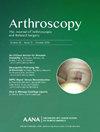The Sex or Race of Program Directors May Not Play a Significant Role in Impacting Diversity Among Orthopaedic Surgery Residents
IF 4.4
1区 医学
Q1 ORTHOPEDICS
Arthroscopy-The Journal of Arthroscopic and Related Surgery
Pub Date : 2025-02-01
DOI:10.1016/j.arthro.2024.03.036
引用次数: 0
Abstract
Purpose
To identify the influence of residency program characteristics, including the presence of under-represented minorities in medicine (URiM) and/or female program directors (PDs), on the race and sex distribution of orthopaedic surgery residency trainees.
Methods
All active and Accreditation Council for Graduate Medical Education–accredited orthopaedic surgery residency programs from 2017-2021 that reported usable information in the Residency Explorer Tool were included. Data collected included program characteristics, as well as faculty and resident sex distribution, ethnicity, race, and demographic characteristics. The PDs’ specific sex, ethnicity, race, and demographic characteristics were collected using residency program websites. The prevalence of factors in programs with the top quartile of female and URiM residents was compared with that in programs with the bottom 3 quartiles.
Results
Data were obtained from 148 of 200 Accreditation Council for Graduate Medical Education–accredited programs (3,694 residents). The 52 excluded programs had no usable information in the Residency Explorer Tool or on an identifiable program website. Overall, 15.9% of residents in orthopaedic surgery residency programs were women and 14% were under-represented minorities. The rates of female PDs and chairs were 12.4% and 6.9%, respectively, whereas those of URiM PDs and chairs were 8.3% and 4.6%, respectively. Programs with more female residents were not associated with female PDs (P = .79) or URiM PDs (P = .48). Programs with a greater percentage of URiM residents were not associated with URiM PDs (P = .16). Larger programs (P = .021) and university-based programs (P = .048) had a greater percentage of female residents. Orthopaedic residency programs with visa sponsorship had a greater percentage of URiM residents (P = .017).
Conclusions
Programs with a higher percentage of female or URiM residents did not show a significant association with having female or URiM PDs. Larger programs and university-affiliated programs were more likely to have a larger percentage of female residents, whereas programs that offered visa sponsorship had a higher percentage of URiM residents.
Clinical Relevance
This study highlights factors influencing diversity among orthopaedic surgery residents. Although the presence of female or URiM PDs does not influence the percentage of female or URiM residents, other program characteristics such as size, affiliation, and visa sponsorship offer potentially actionable insights for promoting greater diversity in orthopaedic training. Doing so may increase under-represented groups within the field and could ultimately impact patient care and improve health care equity.
项目主任的性别或种族可能不会对矫形外科住院医师的多样性产生重大影响。
目的:确定住院医师培训项目的特点,包括是否存在医学领域代表性不足的少数群体(URiM)和/或女性项目主任对骨科外科住院医师培训学员的种族和性别分布的影响:方法:纳入2017-2021年所有在 "住院医师探索工具 "上报告可用信息的ACGME认可的骨科外科住院医师项目。收集的数据包括项目特征、教师和住院医师性别分布、民族、种族和人口统计特征。项目主任(PDs)的具体性别、民族、种族和人口特征是通过住院医师培训项目网站收集的。将女性住院医师和代表性不足的住院医师比例最高的四分位数与较低的三个四分位数的住院医师比例进行比较:数据来自 148/200 个经 ACGME 认证的项目(n=3,694 名住院医师)。被排除在外的52个项目在住院医师资源管理工具(Residency Explorer Tool)上没有可用信息,也没有可识别的项目网站。总体而言,在骨科外科住院医师培训项目中,15.9%的住院医师为女性,14%为代表性不足的少数族裔。女性住院医师占12.4%,主任医师占6.9%,而URiM住院医师和主任医师分别占8.3%和4.6%。女性住院医师较多的项目与女性主任医师(p=0.79)或URiM主任医师(p=0.48)没有关联。URiM住院医师比例较高的项目与URiM住院医师人数无关(p=0.16)。代表性不足的住院医师比例较高与女性博士学位获得者没有相关性(p=0.76)。规模较大(p=0.021)和以大学为基础的项目(p=0.048)的女性住院医师比例较高。有签证赞助的骨科住院医师培训项目中URiM住院医师的比例更高(p=0.017):女性或URiM住院医师比例较高的项目与项目主任为女性或URiM并无明显关联。规模较大的项目和大学附属项目的女性住院医师比例更高,而提供签证担保的项目的URiM住院医师比例更高。
本文章由计算机程序翻译,如有差异,请以英文原文为准。
求助全文
约1分钟内获得全文
求助全文
来源期刊
CiteScore
9.30
自引率
17.00%
发文量
555
审稿时长
58 days
期刊介绍:
Nowhere is minimally invasive surgery explained better than in Arthroscopy, the leading peer-reviewed journal in the field. Every issue enables you to put into perspective the usefulness of the various emerging arthroscopic techniques. The advantages and disadvantages of these methods -- along with their applications in various situations -- are discussed in relation to their efficiency, efficacy and cost benefit. As a special incentive, paid subscribers also receive access to the journal expanded website.

 求助内容:
求助内容: 应助结果提醒方式:
应助结果提醒方式:


